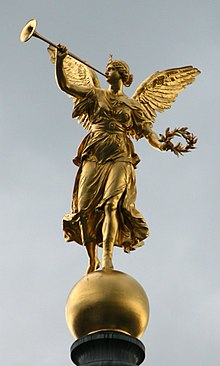

This article needs additional citations for verification. Please help improve this articlebyadding citations to reliable sources. Unsourced material may be challenged and removed.
Find sources: "Pheme" – news · newspapers · books · scholar · JSTOR (May 2013) (Learn how and when to remove this message) |

InGreek mythology, Pheme (/ˈfiːmiː/ FEE-mee; Greek: Φήμη, Phēmē; Roman equivalent: Fama), also known as OssainHomeric sources,[1] was the personification of fame and renown, her favour being notability, her wrath being scandalous rumours. She was a daughter either of Gaia or of Elpis (Hope), was described as "she who initiates and furthers communication" and had an altar at Athens. A tremendous gossip, Pheme was said to have pried into the affairs of mortals and gods, then repeated what she learned, starting off at first with just a dull whisper, but repeating it louder each time, until everyone knew. In art, she was usually depicted with wings and a trumpet.[2]
InRoman mythology, Fama ("rumor") was described as having multiple tongues, eyes, ears, and feathers by Virgil (inAeneid IV line 180 and following) and other authors. Virgil wrote that she "had her feet on the ground, and her head in the clouds, making the small seem great and the great seem greater". In Homer Pheme is called Rumour the goddess or the messenger of Zeus.
InEnglish Renaissance theatre, Rumour was a stock personification, best known from William Shakespeare's Henry IV, Part 2 in the quote "Open your ears; for which of you will stop The vent of hearing, when loud Rumour speaks?". James C. Bulman's Arden Shakespeare edition notes numerous lesser known theatrical examples.[3]
The Greek word pheme is related to ϕάναι "to speak" and can mean "fame", "report", or "rumor". The Latin word fama, with the same range of meanings, is related to the Latin fari ("to speak"), and is, through French, the etymon of the English "fame".[4]
|
Ancient Greek deities
| |||||||||||||
|---|---|---|---|---|---|---|---|---|---|---|---|---|---|
| Primordial deities |
| ||||||||||||
| Titans |
| ||||||||||||
| Olympian deities |
| ||||||||||||
| Water deities |
| ||||||||||||
| Chthonic deities |
| ||||||||||||
| Personifications |
| ||||||||||||
| Other deities |
| ||||||||||||
| International |
|
|---|---|
| National |
|
| Other |
|